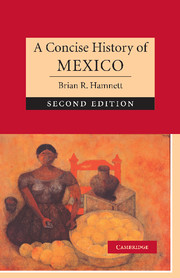Book contents
- Frontmatter
- Contents
- List of illustrations
- Chronology
- Preface to the second edition
- Preface to the first edition
- 1 Mexico in perspective
- 2 The pre-Columbian era
- 3 The European incursion, 1519–1620
- 4 New Spain, 1620–1770: Spanish colonialism and American society
- 5 Destabilisation and fragmentation, 1770–1867
- 6 Reconstruction, 1867–1940
- 7 The monopoly party, 1940–2000
- 8 The Fox administration, 2000–2006
- 9 Cultural developments since Independence
- Final comments
- Bibliography
- Index
- Titles in the series
4 - New Spain, 1620–1770: Spanish colonialism and American society
Published online by Cambridge University Press: 05 June 2014
- Frontmatter
- Contents
- List of illustrations
- Chronology
- Preface to the second edition
- Preface to the first edition
- 1 Mexico in perspective
- 2 The pre-Columbian era
- 3 The European incursion, 1519–1620
- 4 New Spain, 1620–1770: Spanish colonialism and American society
- 5 Destabilisation and fragmentation, 1770–1867
- 6 Reconstruction, 1867–1940
- 7 The monopoly party, 1940–2000
- 8 The Fox administration, 2000–2006
- 9 Cultural developments since Independence
- Final comments
- Bibliography
- Index
- Titles in the series
Summary
The Americas became part of the Atlantic world from the sixteenth century. Each territory had a specific relationship to its metropolis and to the world market. The importance of Spain's two principal colonial territories, New Spain and Peru, lay in their role as principal world producers of silver. This commodity was in short supply in early modern Europe, though demand was great, especially as the main medium of exchange in the Asiatic trade. For nearly four hundred years, until the collapse of world silver prices from the 1870s, Mexico, which surpassed Peru in capacity after the 1690s, placed large quantities of silver on the world market.
Spain's international position, however, deteriorated significantly after the 1640s. In many respects, the American territories were left to their own devices. Substantial colonial revenues remained within the American territories, allocated to the internal budget and to defence needs. In economic terms, the empire moved away from the Spanish metropolis during the course of the seventeenth century, especially after the 1620s, when the transatlantic trade declined. In spite of strong efforts to tap American resources, Spain's European position worsened. This situation, however, did not lead to increased political independence on the part of the American territories, since the political centre of the empire still remained in Spain and the incentive to separate was absent at that time.
SPAIN AND THE EMPIRE: MERCHANTS, FINANCIERS, AND MARKETS
Historians, especially those viewing Ibero-America from Europeanist perspectives, have focussed on the issue of how America fared during the European recession of the mid-seventeenth century.
- Type
- Chapter
- Information
- A Concise History of Mexico , pp. 80 - 110Publisher: Cambridge University PressPrint publication year: 2006

